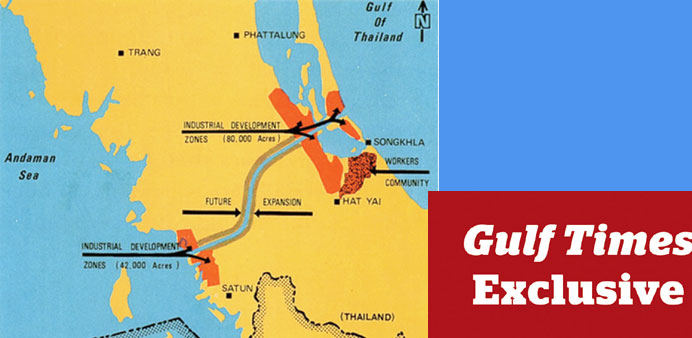Planned route of the Kra Canal, a shortcut between the Gulf of Thailand and the Indian Ocean. Source: International Institute of Marine Surveying.
By Arno Maierbrugger/Gulf Times Correspondent/Bangkok
China and Thailand last week agreed on a long-proposed project, the Kra Canal (also called: Thai Canal), which would cut across the Kra Isthmus in southern Thailand and provide a shipping shortcut similar to the Panama Canal or the Suez Canal in their respective regions. The canal, whose construction costs are calculated to be $28bn, is meant to offer an alternative sea link between Asia, the Middle East and Europe, bypassing the busy Strait of Malacca. The project will take about 10 years to complete, employ roughly 30,000 workers and will allow the passage of any type of cargo vessels up to ultra large crude carriers, or supertankers, the largest presently operating cargo vessels in the world.
According to Chinese media, a memorandum of co-operation between the two countries has been signed in Guangzhou on May 15 to build the canal across the narrowest part of the Malay Peninsula as part of China’s New Maritime Silk Road initiative.
According to the plan, the canal will be built as a two-way 25-metre-deep waterway between the cities of Songkhla and Satun, starting in Songkhla Lake, the largest natural lake in Thailand, and follow the route of Highway 406 that cuts across the peninsula’s interior mountain range. The canal will be 102 kilometres long and, at its widest point, span over 400 metres in width. In comparison: The length of the Panama Canal is 77 kilometres, and the Suez Canal is 192 kilometres long.
The canal, which reportedly will be completely financed by China and mainly built by Chinese companies under the umbrella of the China-Thailand Kra Infrastructure Investment and Development Company, is a strategically important project for Beijing in terms of energy security and also in terms of its economic influence in Southeast Asia.
Currently, around 80% of China’s oil comes from the Middle East and most of it has to pass through the Strait of Malacca. The Kra Canal will shorten this route by some 1,200 kilometres and thereby significantly reduce transport costs for oil and other cargo as ships will be able to pass from the Indian Ocean into the Gulf of Thailand and back. They canal will also end the exposure of cargo ships to pirates in the Strait of Malacca, as well as fears that other countries, namely the US, would block the Strait of Malacca to cut off China’s oil supply in the case of political tensions.
For Thailand, the canal is expected to provide an economic boost for the largely impoverished and conflict-stricken southern region whose economy mainly relies on rubber production. Together with the canal, China is planning to build port facilities, industrial zones and even a refinery.
Thailand could further collect shipping fees for oil tankers from nations that would likely also use the canal such as Japan and South Korea, both of which import most of its oil from the Middle East, and for cargo ships.
For China, the Kra Canal is the second alternative new lifeline for its energy support after it opened both an oil and a gas pipeline leading from Myanmar’s Bay of Bengal coast across the country to Kunming in southern China, also bypassing the Strait of Malacca.

